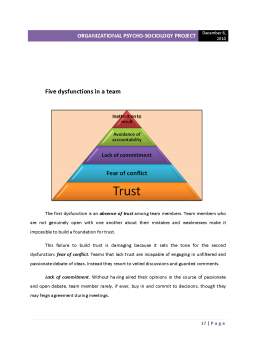Cuprins
- 1. Communication 3
- Case study 1 3
- Recommendation 7
- 2. Leadership 8
- Case study 2 9
- Recommendation 13
- 3. Team work 13
- Why a team 13
- Characteristics of a high performing team 14
- Team work game: Perfect Hexagon 15
- Five dysfunctions of a team 17
- References 18
Extras din proiect
1. Communication
We can define the corporate communication as a transfer of messages and meanings between sender and receiver in an organizational context.
Taking in consideration organizational communication, quality and the speed of feed-back, are fundamentals principles of a modern company.
Many of problems that arise in an organization are the direct result of communication errors.
These damages in communication can cause confusion, misunderstanding or, even worse, failure in fulfilling the tasks.
Communication barriers are all those disturbances that can intervene during the communication process and reduces the fidelity or efficiency message.
The following example is a relevant one of poor communication in an organizational level.
We will try to analyze the errors and communication barriers that can become a significant obstacle to fulfill tasks.
Case study 1
Gabrielle is a young 25 years employee who works in the branch of a well known banking institution. Due to her highly developed communication skills and good performance obtained during the three years since working at this company, Gabrielle is newly promoted on a post that involves advising the bank’s most important clients.
One day, one of those customers, desiring to conclude a contract for a loan application, addresses a question to Gabrielle regarding one of the contractual terms.
Gabrielle is not sure about the answer that she should offer, but because a fundamental principle of the company is customer orientation and customers care, she wants to provide the desired information in a short time. So, Gabrielle decides to seek help from the direct supervisor, the branch manager, whose name is Jack.
Gabrielle: Hello, I really need to talk with you about a customer
Jack: It is important? In two minutes I have to go to a meeting.
Gabrielle: I'll try to be as short as possible.
Jack: Well, tell me quickly what is it (the phone rings, but Jack is waiting to finish the conversation before responding)
Gabrielle: One of my clients wants to access European funds for a project, but I don’t know what answer to give him, concerning the conditions imposed by the European Union, in order to access those funds.I thought that you were the most qualified to be able to help me clarify this issue.
Jack: Read the rules of banking and you will surely find an answer there (stressed looking at the clock)
Gabrielle: I have already consulted its, but the client wants details that I cannot provide and today at two o'clock I set up a meeting with him to elucidate the issue.
Jack: Now I don’t have time for this, and besides that, it’s not my fault you fail to meet your job requirements.
Gabrielle: But now is not about my….
Jack: Oh, please, stop being a classic example of McGregor theory.
Gabrielle: Yes, I understand (reading the doubt on her face), but I thought that company’s policy is to support the client regardless the situation.
Jack: Ok, Ok. I will see how I can solve it. Now I have to go.
The above example is a classic one of organizational communication that takes place between manager and subordinate.
In this case, each of the participants at the communication process plays both roles: transmitter and receiver.
Level of communication: The communication takes place, at internal level of organization and is interpersonal. The communication between Gabrielle and Jack is not only a verbal one, but also a nonverbal. Even though this example doesn’t refer to many body signals, we can imagine that both the manager and subordinate send many nonverbal messages (“… stressed looking at the clock… “/“…reading the doubt on her face…”)
Preview document
Conținut arhivă zip
- Organizational Psychosociology Project.docx






















